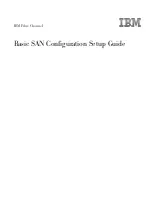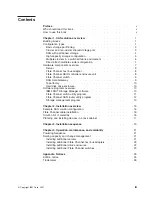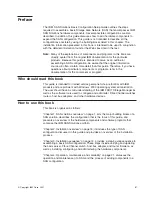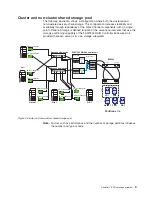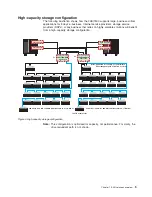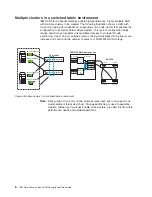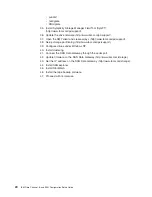
Multiple clusters in a switched fabric environment
IBM SAN Fibre Channel switches enable high-performance, highly scalable SAN
with multiple clusters to be created. The following illustration shows a SAN with
four-port grouping (for redundancy) supporting a two-node cluster that enables the
configuration to accommodate multiple clusters. This type of configuration helps
reduce downtime and enables unencumbered access to storage through
partitioning. Use of 16-port switches (versus the 8-port displayed in the figure) can
increase port count and the number of servers or FAStT500 RAID storage.
Note:
Each group of four ports on the switches (gray dash box) can support one
cluster element (black dash box). Storage partitioning is used to separate
clusters. Sixteen port switches enable more clusters, provided this fits within
performance needs and available partitions.
FC switches
Mini-hub
Host side
Mini-hub
Mini-hub
Mini-hub
FAStT500 RAID controller unit
Ctrl
B
Ctrl
A
Mini-hub
Mini-hub
Mini-hub
Mini-hub
Drive side
EXP500
Loop1
Loop1
Loop2
Loop2
OUT
OUT
OUT
OUT
IN
IN
IN
IN
FC host adapter
FC host adapter
FC host adapter
FC host adapter
Figure 5. Multiple clusters in a switched fabric environment
6
IBM Fibre Channel: Basic SAN Configuration Setup Guide
Summary of Contents for 86596ry - Servers Netfinity Pentium 3
Page 1: ...IBM Fibre Channel Basic SAN Configuration Setup Guide...
Page 2: ......
Page 3: ...IBM Fibre Channel Basic SAN Configuration Setup Guide...
Page 6: ...iv IBM Fibre Channel Basic SAN Configuration Setup Guide...
Page 8: ...vi IBM Fibre Channel Basic SAN Configuration Setup Guide...
Page 22: ...14 IBM Fibre Channel Basic SAN Configuration Setup Guide...
Page 26: ...18 IBM Fibre Channel Basic SAN Configuration Setup Guide...
Page 32: ...24 IBM Fibre Channel Basic SAN Configuration Setup Guide...
Page 35: ......



